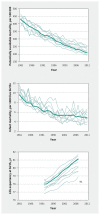Effect of provincial spending on social services and health care on health outcomes in Canada: an observational longitudinal study
- PMID: 29358200
- PMCID: PMC5780265
- DOI: 10.1503/cmaj.170132
Effect of provincial spending on social services and health care on health outcomes in Canada: an observational longitudinal study
Abstract
Background: Escalating health care spending is a concern in Western countries, given the lack of evidence of a direct connection between spending and improvements in health. We aimed to determine the association between spending on health care and social programs and health outcomes in Canada.
Methods: We used retrospective data from Canadian provincial expenditure reports, for the period 1981 to 2011, to model the effects of social and health spending (as a ratio, social/health) on potentially avoidable mortality, infant mortality and life expectancy. We used linear regressions, accounting for provincial fixed effects and time, and controlling for confounding variables at the provincial level.
Results: A 1-cent increase in social spending per dollar spent on health was associated with a 0.1% (95% confidence interval [CI] 0.04% to 0.16%) decrease in potentially avoidable mortality and a 0.01% (95% CI 0.01% to 0.02%) increase in life expectancy. The ratio had a statistically nonsignificant relationship with infant mortality (p = 0.2).
Interpretation: Population-level health outcomes could benefit from a reallocation of government dollars from health to social spending, even if total government spending were left unchanged. This result is consistent with other findings from Canada and the United States.
© 2018 Joule Inc. or its licensors.
Conflict of interest statement
Competing interests: None declared.
Figures


Comment in
-
The need for health in all policies in Canada.CMAJ. 2018 Jan 22;190(3):E64-E65. doi: 10.1503/cmaj.171530. CMAJ. 2018. PMID: 29358199 Free PMC article. No abstract available.
-
Fueling the culture of distrust in physicians.CMAJ. 2018 Mar 26;190(12):E370. doi: 10.1503/cmaj.69008. CMAJ. 2018. PMID: 29581165 Free PMC article. No abstract available.
-
Creating the conditions that allow health for all to emerge.CMAJ. 2018 Mar 26;190(12):E371. doi: 10.1503/cmaj.69129. CMAJ. 2018. PMID: 29581166 Free PMC article. No abstract available.
-
Money Spent on Social Services Improves Health Outcomes.Am J Nurs. 2018 Apr;118(4):69. doi: 10.1097/01.NAJ.0000532081.95242.b6. Am J Nurs. 2018. PMID: 29596261
References
-
- Marchildon GP, Di Matteo L, editors. Bending the cost curve in health care: Canada’s provinces in international perspective. Toronto: University of Toronto Press; 2014.
-
- Fiscal sustainability of health systems. Paris (France): OECD Publishing; 2015.
-
- Bradley EH, Elkins BR, Herrin J, et al. Health and social services expenditures: associations with health outcomes. BMJ Qual Saf 2011;20:826–31. - PubMed
-
- Bradley EH, Taylor LA. The American health care paradox: why spending more is getting us less. New York: Public Affairs; 2013.
-
- Rubin J, Taylor J, Krapels J, et al. Are better health outcomes related to social expenditure? A cross-national empirical analysis of social expenditure and population health measures. Cambridge (UK): RAND Europe; 2016.
Publication types
MeSH terms
LinkOut - more resources
Full Text Sources
Other Literature Sources
